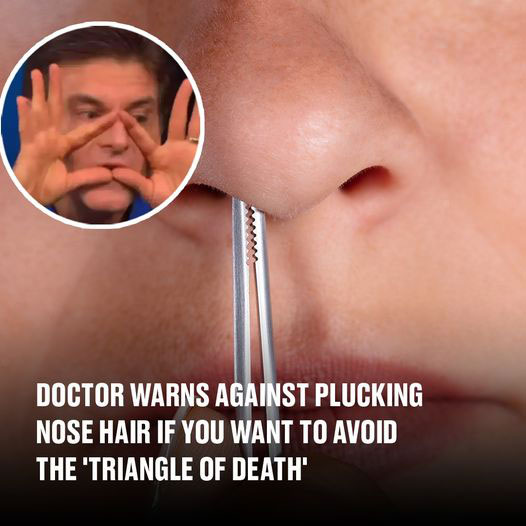Nose hair may seem unsightly, but they play a crucial role in maintaining your health. However, the common practice of plucking nose hairs can lead to severe health risks, including a potentially fatal condition referred to as the “triangle of death.” Dr. Erich Voigt, an otolaryngologist at New York University, along with various studies, has insights into why this seemingly harmless habit should be avoided.
The Importance of Nose Hair

Nose hairs, medically termed ‘vibrissae,’ serve as the first line of defense against dust, allergens, and other small particles. These hairs trap unwanted debris, preventing them from entering the lungs and causing respiratory issues.1 Additionally, the nose is lined with microscopic hairs called cilia, which help move mucus and trapped particles to the throat, where they are either swallowed or expelled.2
Risks Associated with Plucking Nose Hair

Plucking nose hairs can lead to several complications, such as ingrown hairs, nasal vestibulitis, and nasal furunculosis. An ingrown hair occurs when hair grows back into the skin instead of out of it, causing irritation and infection. Nasal vestibulitis, an infection of the nasal vestibule, can develop from minor injuries like plucking. This condition is characterized by redness, pain, and pimples inside the nose. Nasal furunculosis is a deeper infection that can cause pain and swelling and, in severe cases, may lead to serious health issues if the infection spreads.
The ‘Triangle of Death’

The term “triangle of death” refers to the area of the face that includes the nose and upper lip. This region is highly susceptible to infections because the veins that drain this area are connected to the veins at the base of the brain. Plucking nose hairs can create an entry point for bacteria, which can travel through these veins and potentially cause life-threatening conditions such as cavernous sinus thrombosis, cellulitis, or meningitis. These infections are rare but can be extremely dangerous, particularly for individuals with weakened immune systems.
Alternatives to Plucking

Rather than plucking nose hair, safer methods include trimming with scissors or using electric trimmers specifically designed for the job.3 These methods reduce the risk of irritation and infection by not disturbing the hair follicles. Laser hair removal is another option, though it is more expensive and comes with its own set of risks. However, laser treatment should only be performed by a qualified professional.
Trimming Techniques
- Use scissors with rounded tips: These are designed to prevent injury while trimming visible nose hairs.
- Electric nose trimmers: These provide a safer alternative to scissors and plucking nose hairs, reducing the risk of cuts and infections.
Laser Hair Removal
- Consult a professional: Ensure the procedure is performed by a board-certified dermatologist or plastic surgeon.
- Consider the risks: Laser hair removal can damage the mucous membranes inside the nose if not done correctly.
The Role of Nose Hair in Respiratory Health

Nose hair density is directly linked to respiratory health. A 2011 study found that individuals with fewer nose hairs had a higher risk of developing asthma due to increased exposure to allergens.4 The study highlighted the protective function of nose hairs in filtering out harmful particles, thereby reducing the likelihood of respiratory issues. Plucking nose hairs does, in fact, reduce the number of them available, putting the plucker at greater risk, according to this study.
Conclusion

While grooming habits are often influenced by aesthetic preferences, it is crucial to understand the health implications of plucking nose hairs. The risk of severe infections, coupled with the essential protective role nose hairs play, makes trimming a safer and more advisable option. Maintaining nose hair hygiene without resorting to plucking can prevent potential health complications and safeguard your well-being. Following safe hair removal practices and understanding the critical functions of nose hairs, you can avoid the dangers associated with plucking and keep the “triangle of death” at bay.
